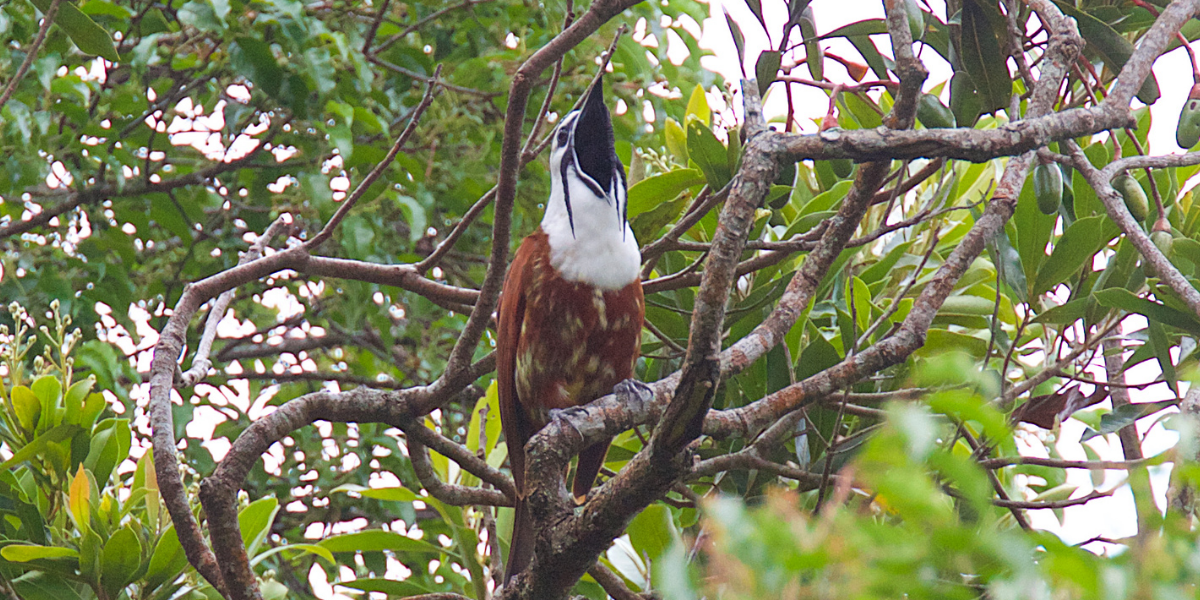The Arrival of the Three-Wattled Bellbird

Seasonal migrations of numerous bird species throughout the year make birdwatching in Monteverde a dynamic activity, where each month can bring a vastly different experience for birders seeking the rare and magnificent birds that visit Monteverde.
Among the many avian species that call Monteverde home throughout the year, one of the most sought-after and fascinating is the Three-Wattled Bellbird, whose strange and haunting calls have begun to echo out in earnest across Monteverde as of the time of writing.
In this article, we’ll get to know the Three-Wattled Bellbird a little better, and learn from Ocotea’s leading birding expert about the rich culture of birdwatching and wildlife photography in Monteverde.
Getting to Know the Three-Wattled Bellbird (Procnias tricarunculatus)
-1.png?width=903&height=541&name=The%20Arrival%20of%20the%20Three-Wattled%20Bellbird%20(4)-1.png)
In the words of our longtime correspondent Olga Saenz Carbonell, one of the most remarkable experiences for newcomers on the Monteverde trails is noticing the almost dissonant sounds emanating from the treetops when the Three-Wattled Bellbird is in the area. The bell-like call is so clear and loud that it echoes throughout the forest, urging you to pause, listen, and raise your binoculars to the canopy.
If you're fortunate enough to be at the top of a trail, on a platform, or on a bridge, you might spot it nearby, producing these unusual, cacophonous calls.
The male is unmistakable with its dark rufous body, white head and breast, and three bare wattles dangling from its bill (for which the bird is named). When singing, it often sits in a prominent position, signaling birders all around to look lively and keep their eyes on the trees.
In contrast, the female has a drab olive body with yellower striping on the underparts, to better focus on camouflage.
The Three-Wattled Found is primarily in the canopy of woodlands where it's easiest to spot when singing, although it also feeds on fruiting trees like the Ocotea Tree in the Ocotea Boutique Hotel’s back garden.
An Interview with Ocotea’s Leading Birding Expert
-1.jpg?width=1128&height=676&name=The%20Arrival%20of%20the%20Three-Wattled%20Bellbird%20(2)-1.jpg)
To get a better understanding of these rare seasonal visitors to Monteverde, we reached out to Oscar Fennell, a local guide with decades of experience on the trails of the Monteverde reserves who specializes in birding, and has a personal connection to Monteverde’s vibrant birding community.
Ocotea Team: Just how popular is birdwatching in Monteverde? We know that Costa Rica is an incredible destination for birding, do those people make their way to Monteverde often?
Oscar Fennell: This activity occurs with a high frequency at the hotel and in the Monteverde area. There are many guides in Monteverde and every day you see people taking the bird tour with different guides. We’re not sure of the exact numbers, but when most guides are taking out multiple tours each day, you can see it’s a popular activity!
OT: Wow, quite a lot of people are interested in birding! We’ve heard Monteverde called one of the world’s foremost destinations for bird watching and photography, would you say that’s accurate?
Oscar: It is exactly like that. A significant number of visitors come to Monteverde interested in birds, and that makes sense. After all, we have different reserves, life zones, diversity of species, etc., all in a relatively small area, so there’s an incredible amount to see. Also, there are some notable species of great interest to bird watchers, like the Resplendent Quetzal and the Three-Wattled Bellbird.
OT: What time of year does the Three-Wattled Bellbird live in Monteverde, and what happens when they come to town?
Oscar: The bellbird generally begins to arrive in Monteverde in February. Many tourists hear that they can be spotted here at that time, and understandably want to see it, although it is not easy, as they’re rare early in the year.
Near the town of Monteverde, however, they could become more common in May, June, and July, and visitors find more success finding them (though obviously, we can never make promises about the behavior of wild animals).
It is worth seeking out if you’re here, especially in those months. The loud sound it produces is reason enough to try to see it, and when you spot it up in the trees singing, you can understand why the bird is a great attraction for travelers to come to the area.
OT: What is the birdwatching community like in Monteverde? Is it centralized, with key people keeping everyone together? How does everyone stay in touch?
Oscar: This is a place where technology helps us stay in contact. Guides specialized in birds are always uploading photos and inviting other guides to the discussion via chats and WhatsApp groups. In the same way, ornithological biologists also share information based on their studies.
Some chats mix guides with biologists and there is a certain harmony in which the guides learn from the biologists and the biologists use observations from guides for their research.
There’s also a sense of community out in the reserves. When you spot something beautiful, you always tell the other guides you find, and together, with many eyes throughout the reserve, we have a much better chance of spotting these animals.
OT: We’ve talked a bit about how these birds can be unpredictable. As residents of Monteverde, have you ever seen rare birds like quetzals or bellbirds in your daily life?
Oscar: Of course. Birds, like other animals, are unpredictable, so it’s hard to know where you may encounter them, whether that’s out in a reserve or in a tree in your backyard. On many occasions, people who are not guides or biologists, but are residents of the community, will spot these birds in many places as they pass through Monteverde.
OT: That’s pretty incredible, that you have a chance in your daily life to encounter highly sought-after birds that many people travel thousands of miles to see. What is it like to live in such a glorious natural place?
Oscar: It is incredible to live in an environment like Monteverde, with such a strong identity of conservation, many biological reserves in the area, so many specialists who live here, and such biological diversity present. We are blessed to live here and are committed to always improving.
OT: That’s amazing to hear! As we wind down this interview, do you have any interesting facts about the Three Wattled-Bellbird to share?
Oscar: Ah, yes, there are many interesting things to share. Oftentimes, when we see one, tourists say “It has some worms hanging from its beak,” but they’re actually the ‘wattles’ for which the bird is named.
Also, the sound of the bellbird is truly impressive, and experts can determine the difference not only in the cry but also in the dialect between males and females, which each have their own set of sounds and “phrases.”
In the times of year when the Resplendent Quetzal is not in the area, the chance to hear this haunting sound becomes the biggest attraction in Monteverde, and it can be a truly eye-opening experience.
The Call of the Three-Wattled Bellbird
If you’d like to hear the call of the Three-Wattled Bellbird, we can recommend watching this video on YouTube for an idea, but there’s nothing like hearing it for yourself! If you’re interested in coming to explore the cloud forest of Monteverde with us and see some of these fascinating birds for yourself, you can reach out to us using the contact form at the bottom of the page.
And in the meantime, we’d like to thank Oscar for taking the time to discuss this beautiful creature with us!




.jpg)
.jpg)